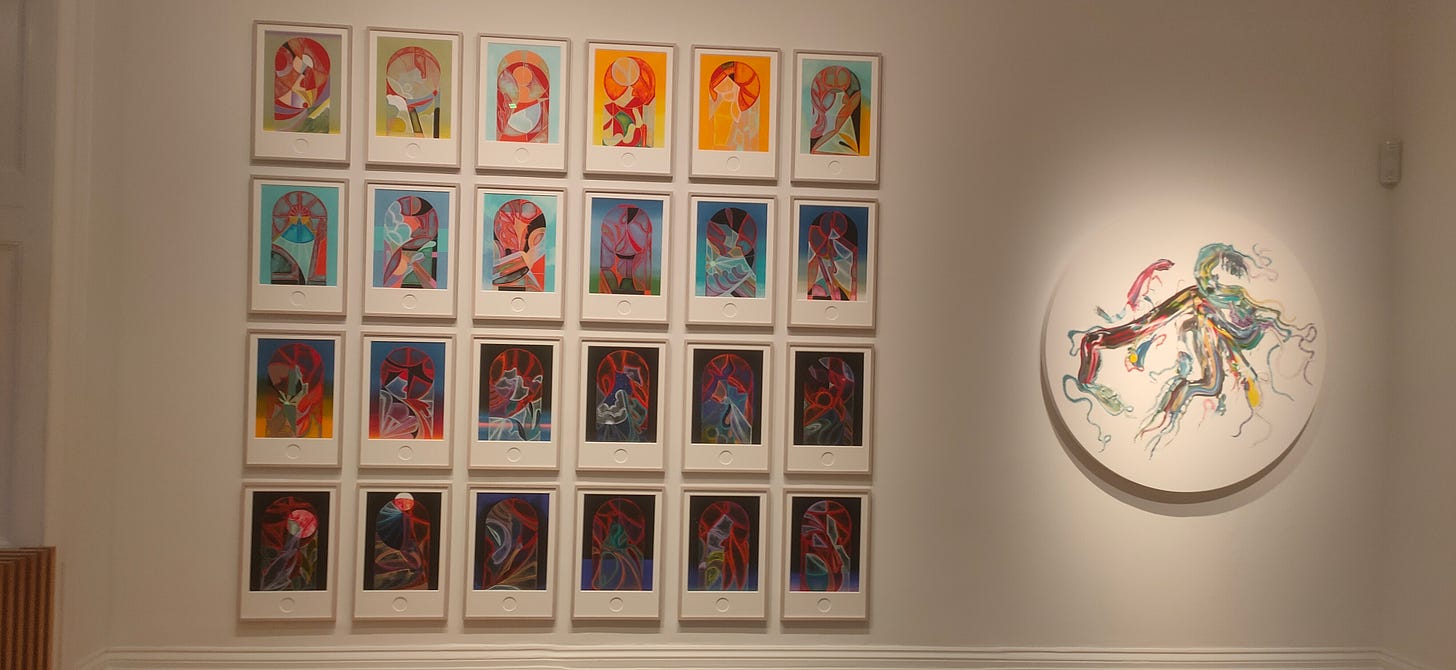Cromwell Place Galleries
Yesterday’s plan was Natural History Museum. While going there from South Kensington Station, I noticed an art gallery. I didn’t think much about it but then, while returning back, I noticed it again. Curious, I went in and asked; we were told it’s open for viewing. The website describes the place as
A row of five townhouses in South Kensington. Home to a programme of exhibitions and events across our beautiful gallery spaces.
The galleries present are diverse and interesting - the first one titled Pioneers of Fashion showcases the fashion photography and illustrations by Lee Miller & Carl Erickson - there are full sketches and photographs, and then, there are samples of their work from Vogue half a century ago.
Added bonus is a 2017 copy of Drawing on Style - something which I never heard, but something which is really good.
The next one seems to be the main one in this set of exhibitions - Journey of the Mind. This one is a kind of introduction to Sikhism and has got some very good depictions. But the narrative is Pure Vairagya(complete detachment from society) - clearly, not my cup of coffee. Have a look at some samples below.
Attachment to the external world, through objects, relationships and even thoughts, is a negative force. A mind that is free of attachment has the foresight to be selfless.
But living in a society that is preoccupied with individual advancement, standing up for the truth and others can feel like a big task.
To be alone can be daunting, overcome by feelings of sadness and emptiness. Other people in day-to-day life influence the mind, negatively or positively. Confidence can be gained from knowing that the mind is not alone once merged with Waheguru(the Creator). This will give the mind the courage and strength to be boundless.
The ability to rise above the internal noise and find spiritual strength is the purpose of taking the journey, starting with Simran(a focused practice) which helps provide clarity.
However, the important bit is the Sikh version of the standard Oriental Meditation Routine. It is given in much detail. Whatever religion you are in, you can follow this one.
The external and internal world is full of negative forces - hatred, intolerance, ignorance, ego and attachment. But it is possible to find peace by looking inwards, through the journey of the mind. This journey starts with Simran(note: it's Smaran in Sanskrit), which is the practice of focused repetition of the Gurumantar, the Creator's name - Waheguru. As the Gurmantar is repeated, thoughts are eliminated and the mind is cleansed. To try it, close your eyes and place your full focus in Waheguru, listening to Waheguru as you chant. With practice, the aim is to repeat the Gurmantar with every breath - wherever you are and whatever you are doing. Eventually the mouth and tongue won't do the chanting, the mind will start doing it day and night, even when you are asleep. Through Simran, the Shabad(Sound of Waheguru) will be heard, which will take you to the Dasam Dwaar(Tenth Door) through which Waheguru can be met. But for now, try it for a few minutes and see how it makes you feel. This could be the beginning of your journey of the mind.
Notes: This is nothing more than the typical Oriental Meditation practiced in every religion in the area. The chants may vary with religion but the process is exactly identical.
Before making this a heavy article, let me present some good depictions from this gallery. And then there is the Sikh trauma - the images of which I am not going to depict.
But then, the associated worksheet given is too good. It’s a kind of self help booklet - a diary for one week to note down how the thoughts are modelled as time goes through as you perform meditation.
The next one is a combination of two - Space Race. Now, don’t ask me what it is! The formal description goes thus.
The works on view, which include painting, sculpture, and mixed media, use light, color, and unexpected source materials to prompt us to contemplate our place in the universe, explore ideas of spirituality, and engage with varied perceptions of reality. In this context, the term SpaceRace has a dual meaning. It is a reference to the 20th-century competition between two Cold War rivals (the United States and the Soviet Union), who sought dominance in space beyond our planet. It is also a satirical reference to the commodification of Black art in the 21st century.
Same goes for the other ones - The Space Around Us by Sundaram Tagore Gallery. What’s the theme, I have no clue. Don’t get me wrong, the presenters themselves don’t have a clue. It’s just a random mishmash.
The qualities of the environments range from colour-saturated landscapes on canvas to tactile abstract compositions that examine the interplay between paintings and wall surfaces. Presented together, the work demonstrates the varied ways in which artists engage with space to consider ideas of identity, gender, perception, and place.
Together we Thrive is a fundraiser for the Cultural Leaders Programme. It’s a st of 25 A4 artworks showcased together.
All in all, it’s a good timepass. The diversity of the topics is what adds more to the charm here. And that also means whenever you are in the area, just check what’s happening.










